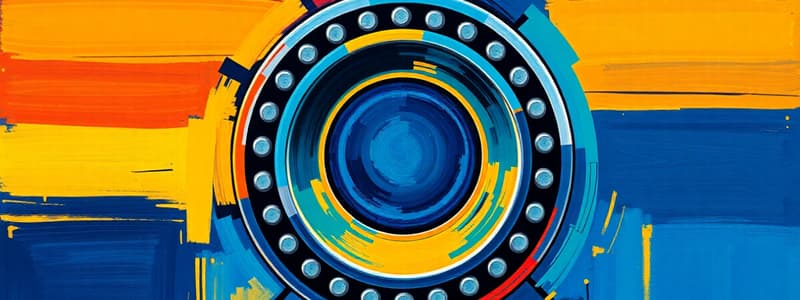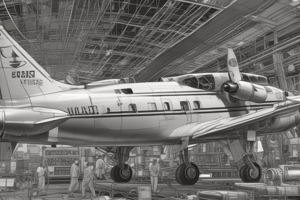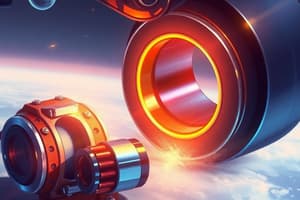Podcast
Questions and Answers
Bearings are designed to withstand pressure while restricting movement on other surfaces to prevent wear.
Bearings are designed to withstand pressure while restricting movement on other surfaces to prevent wear.
False (B)
Why are close tolerances necessary in bearing construction?
Why are close tolerances necessary in bearing construction?
- To provide quiet, efficient operation while permitting freedom of motion (correct)
- To increase noise during operation
- To allow for thermal expansion
- To permit freedom of motion at the expense of efficiency
List three primary sources of loads for both radial and axial directions acting on a bearing.
List three primary sources of loads for both radial and axial directions acting on a bearing.
Weight of rotating mass, axial thrust from the engine, gyroscopic effect during maneuvering.
Which type of load is a resultant of forward and rearward thrust forces?
Which type of load is a resultant of forward and rearward thrust forces?
Radial load acts perpendicular to the shaft.
Radial load acts perpendicular to the shaft.
A load acting at a right angle to the shaft is referred to as a ______ load.
A load acting at a right angle to the shaft is referred to as a ______ load.
Which bearing type provides less friction compared to other bearing types?
Which bearing type provides less friction compared to other bearing types?
Name two types of loads a ball bearing can generally support.
Name two types of loads a ball bearing can generally support.
Roller bearings are designed to limit or support both radial and axial loads.
Roller bearings are designed to limit or support both radial and axial loads.
Why are tapered roller bearings seldom used on engines?
Why are tapered roller bearings seldom used on engines?
Due to constantly changing temperatures in engines, a ______ bearing is often installed on one side of the spool to allow for axial movement due to thermal expansion.
Due to constantly changing temperatures in engines, a ______ bearing is often installed on one side of the spool to allow for axial movement due to thermal expansion.
What type of bearing is typically installed on the other side of the spool to transmit thrust and radial loads to the engine mounts?
What type of bearing is typically installed on the other side of the spool to transmit thrust and radial loads to the engine mounts?
An advantage of lubricating bearings includes reducing temperature.
An advantage of lubricating bearings includes reducing temperature.
Describe the primary purpose of bearing lubrication.
Describe the primary purpose of bearing lubrication.
What is the main purpose of seals in engine bearing chambers?
What is the main purpose of seals in engine bearing chambers?
O-rings are used where maximum leakage is allowed.
O-rings are used where maximum leakage is allowed.
Seals are divided into two major groups: rubbing seals and ______ seals.
Seals are divided into two major groups: rubbing seals and ______ seals.
Match the following seal types with their characteristics:
Match the following seal types with their characteristics:
In what type of application are metal C-rings typically used?
In what type of application are metal C-rings typically used?
In what scenarios are carbon seals typically utilized?
In what scenarios are carbon seals typically utilized?
A labyrinth seal is best suited for applications requiring absolutely no leakage.
A labyrinth seal is best suited for applications requiring absolutely no leakage.
Which of the following is the primary function of pressurized bleed air in a labyrinth seal?
Which of the following is the primary function of pressurized bleed air in a labyrinth seal?
In a labyrinth seal, the air/oil mixture is separated using a ______ to separate air from oil.
In a labyrinth seal, the air/oil mixture is separated using a ______ to separate air from oil.
What are the characteristics of Bearing?
What are the characteristics of Bearing?
Axial load It is a resultant from thrust loads (forward and rearward force).
Axial load It is a resultant from thrust loads (forward and rearward force).
Which bearing withstand heavy thrust load load and radial or centrifugal loads?
Which bearing withstand heavy thrust load load and radial or centrifugal loads?
A ball bearing will limit or support both radial and axial loading.
A ball bearing will limit or support both radial and axial loading.
Seals can be divided into how many major groups?
Seals can be divided into how many major groups?
Non-Rubbing Seals: C-Ring/Clamp are static sealing elements for machines and installations with high-pressure requirements.
Non-Rubbing Seals: C-Ring/Clamp are static sealing elements for machines and installations with high-pressure requirements.
How many the members that the labyrinth seal consist of?
How many the members that the labyrinth seal consist of?
Flashcards
Bearing Characteristics
Bearing Characteristics
Bearings must withstand pressure yet permit movement with minimal wear.
Bearing Design Consideration
Bearing Design Consideration
The parts must be held in close tolerances to provide quiet and efficient operation and at the same time permit freedom of motion
Axial Load
Axial Load
Force along the center of the shaft (forward/rearward).
Radial Load
Radial Load
Signup and view all the flashcards
Ball Bearing
Ball Bearing
Signup and view all the flashcards
Roller Bearing
Roller Bearing
Signup and view all the flashcards
Bearing Configuration
Bearing Configuration
Signup and view all the flashcards
Purpose of Bearing Lubrication
Purpose of Bearing Lubrication
Signup and view all the flashcards
Purpose of Seals
Purpose of Seals
Signup and view all the flashcards
Rubbing Seals
Rubbing Seals
Signup and view all the flashcards
O-Ring
O-Ring
Signup and view all the flashcards
Non-Rubbing Seals
Non-Rubbing Seals
Signup and view all the flashcards
C-Ring/Clamp Seals
C-Ring/Clamp Seals
Signup and view all the flashcards
Carbon Seal
Carbon Seal
Signup and view all the flashcards
Labyrinth Seal
Labyrinth Seal
Signup and view all the flashcards
Study Notes
General Overview
- Key topics include characteristics of bearings, loading, types, configuration on shaft, lubrication, and seals.
- Seals consist of rubbing seals, non-rubbing seals, O-rings, C-Ring/Clamp seals, carbon seals, and labyrinth seals.
Bearings
- Bearings must withstand pressure while permitting movement with minimal wear.
- Parts must be held in close tolerances to provide quiet and efficient operation while allowing freedom of motion.
Loading on Bearings
- Primary loads for both radial and axial directions come from the weight of the rotating mass, axial thrust from the engine, and gyroscopic effect.
- Additional sources of load: compression and tension loads from thermal expansion, and vibration from the engine.
- Axial load results from thrust loads (forward and rearward force).
- Radial load is at a right angle to the shaft.
- Radial load is also caused by RPM changes and aircraft maneuvering.
Types of Bearings
- Bearings include both ball bearings and roller bearings.
- Ball bearings provide less friction than other bearing types.
- Ball bearings withstand heavy thrust, radial, and centrifugal loads.
- Ball bearings limit or support both radial and axial loading.
Roller Bearings
- Roller elements permit axial movement when the engine expands and contracts during operation.
- Roller bearings have a greater surface area than ball bearings for absorbing radial loading.
- Tapered roller bearings are seldom used on engines because they hinder thermal growth.
- Roller bearings limit or support only radial loads.
Bearing Configuration
- Radial bearings are installed on one side of the spool for axial movement due to thermal expansion/growth.
- The other side of the spool has ball bearings to transmit thrust/radial load to the engine mounts.
Bearing Lubrication
- Oil pressure is admitted on the bearing to reduce vibration transmission, clean debris, reduce temperature, and lubricate to extend the bearing's life.
- Oil is applied under pressure to lubricate roller bearings using a squeeze film bearing mechanism.
Seals
- Purpose of using seals is to prevent oil or air leakage from the engine bearing chambers, and on the accessory gearbox.
- Seals consist of 2 major groups, rubbing and non-rubbing.
Rubbing Seals
- Rubbing seals such as O-rings should be applied where minimum leakage is allowed.
Non-Rubbing Seals
- Non-rubbing seals like metal C-rings are static sealing elements for machines and installations requiring high pressure.
- Non-rubbing carbon seals are used when high-pressure fluid is involved.
- Non-rubbing labyrinth seals are used when a controlled/minimum leakage is allowed.
- Labyrinth seals use a rotating member and a static casing mate.
- Seals are used primarily to prevent oil loss after bearing is lubricated.
- Pressurized bleed air seals the oil path from leakages.
- The air/oil mixture will be separated using centrifugal breather to separate air from oil.
Studying That Suits You
Use AI to generate personalized quizzes and flashcards to suit your learning preferences.
Related Documents
Description
Explore the characteristics of aircraft bearings, including how they handle different types of loads and the various seal designs used to protect them. Learn about radial and axial loads, as well as the types and configurations of bearings on the shaft. This overview covers lubrication methods and seal types like rubbing, non-rubbing, and labyrinth seals.



